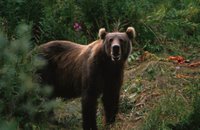 | Title: Kodiak Brown Bear, Alternative Title: Ursus arctos, Creator: Hollingworth, John and Karen, Source: WV10255, Publisher: U. S. Fish and Wildlife Service, Contributor: NATIONAL CONSERVATION TRAINING CENTER-PUBLICATIONS AND TRAINING MATERIALS. |
File size: 137 KB, Format: JPEG Image (image/pjpeg), Dimensions: Screen: 1050px x 681px, Print: 7.00 x 4.54 inches, Resolution: 150 dpi (mid, presentation quality), Depth: Full Color.
Unless otherwise indicated, resources in the Digital Library System are in the public domain. No restrictions or copyrights are placed upon these materials. You may credit the source of the resource using the information contained in the "Creator" or "Rights" field of the resource record. Download Full High Resolution Image
Generally speaking, works created by U.S. Government employees are not eligible for copyright protection in the United States. See Circular 1 "COPYRIGHT BASICS" from the U.S. Copyright Office.
Anyone incorporating a work of the U.S. Government into a copyrighted work should be aware of 17 U.S.C. § 403. This section requires a copyright notice to contain a statement identifying what portions of the work consist of a work of the U.S.Government.
Size range for females is from 500 to 700 pounds and for males 800 to 1,400 pounds. There can be a difference of 20 to 30 percent gain in weight between when they emerge from dens in the spring and when they den up in the late fall.
The oldest recorded bear was a 35 year-old female. The initial breeding age is at approximately six years-old and they will usually have two cubs in the first litter and can have up to four in subsequent litters. The average litter size is 2.3 cubs. In general, most cubs remain with their mothers until they are 2-3 years-old.
Kodiak bears breed in spring (May to early-June) and an adult female may mate with several adult males. Cubs are born in the den the following winter ( January or February) due to delayed implantation, and each sibling cub could be from a different father.
In general, after leaving the den in the spring, bears move to lower elevations where they may feed on carrion, roots or other freshly emergent vegetation. As spring progresses, they feed in the high alpine areas below the snow-line on succulent forbs and sedges. During summer, many bears move to, and stay near, streams when salmon are available in local streams. Between July and September, bears routinely supplement their diet with berries—especially salmonberry, elderberry and crowberry. After berry availability declines in September, most bear use focuses on streams which provide late run salmon. Some bears may prey on deer, but it depends on the individual bear. SOURCE: Bear Facts Kodiak National Wildlife Refuge
Leave a comment, make a request, Let this small sampling be a guide to better quality, more plentiful, public domain, royalty free, copyright free, high resolution, images, stock photos, jpeg, jpg, free for commercial use, clip art, clipart, clip-art. more at Public Domain Clip Art and clip art or public domain and Kodiak Brown Bear or Ursus arctos













No comments:
Post a Comment